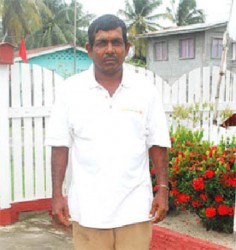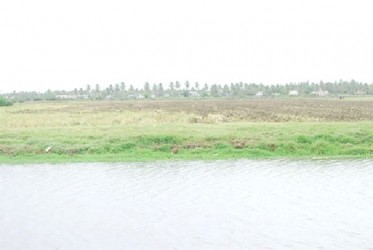President of the Essequibo Paddy Farmers Association (EPFA) Naith Ram is keen to remove what he says might be the misconception that the emergence of a large, reliable market under the ongoing PetroCaribe agreement with neighbouring Venezuela has dramatically altered the fortunes of rice farmers in Essequibo.
In fact, Ram says, conditions in the rice sector in Essequibo have pushed the association to a point of calling for a significant state subsidy that would embrace cheaper fuel, insecticide, fertilizer, and more. And he says farmers have proposed setting up their own mill as a way of dealing with the challenges they face.
Asked about the challenges, he raises the issue of what appears to be unending differences between farmers and millers over protracted delays in settling payments for paddy delivered to the mills. Paddy prices too have been an issue.

The 2014 first crop is pushing towards its final few days. Ram says that more than 85 per cent of the farmers’ paddy has been sold and the controversy over prices persists. The Essequibo millers, he says, are currently offering rates of $3,700 per bag for Extra Grade A paddy and $3,500 for grades of paddy ranging between A, B and C.
What is currently being offered is appreciably higher than what the millers were paying – around $3,100 earlier in the crop – though Ram says it was still below the $4,000 per bag offered during the last crop.
Issues relating to pricing have been among the main points of controversy between farmers and millers, though Ram says attitudes can vary from one miller to the next. He says the current justification for price differentials provided by the millers has to do with world market prices, with the exception, they say, of volumes exported under the PetroCaribe agreement. Ram believes differently and asserts that the rocky relationship between farmers and millers in Essequibo derives from a lack of trust. And while he expects that current paddy prices could still yield farmers a profit, he says what the association seeks is to have the entire relationship between the farmers and the millers revisited.

Controversy over paddy prices would appear to be linked in large measure to differences over the veracity of the grading process used by the mills. It appears that many Essequibo rice farmers hold the view that the grading process is skewed to deny the farmers fair prices for their paddy. Ram says that what the EPFA wants is to have Guyana Rice Development Board (GRDB) officials present at the mills to oversee and pronounce on the grading exercises during the second crop this year.
What is described as the moisture and dockage process subjects the rice to a grain moisture analysis that determines the volume of water in the grain. Dockage is arrived at after a percentage of the paddy is milled then examined for broken rice, red rice and foreign bodies. The outcomes of those processes determine the grade given to the rice and the price paid by the miller.
Ram says that the vicissitudes of pricing, coupled with what are often protracted delays in making payments to farmers have made life difficult for rice farmers. Late payments can mean defaulting on loan repayment deadlines and the consequences accruing therefrom. “People also need money to look after their families,” he says. “There are two crops per year and for six months in each year we are not earning.”
Ram explained some of the mathematical realities of the sector in order to make the point about just how challenging it can be. A cultivated ten-acre plot, he says, will customarily yield around 300 bags of paddy. The cost of producing 300 bags of paddy is around $700,000, Ram says. This includes land preparation, the application of insecticide and fertilizer and, at the other end of the process, harvesting and transporting the paddy. He notes that farmers would normally have to hire a combine to harvest that 10-acre plot.
Ram says the high costs and dwindling profits are as a result of a change in cultural attitudes to the rice sector. He points out that younger generations in traditional rice-farming families no longer necessarily look forward to carrying on the tradition.
The frustrations are compounded by the fact that late payment for paddy has become commonplace. Ram says the practice of late payment does not apply to all of the mills but its impact is felt more-or-less across the board among farmers. He says that delayed payments often have a similar impact to unsatisfactory prices: farmers’ debts cannot be met in a timely manner.
Farmers can seek legal recourse, but Ram says that is not usually the way of the sector. Farmers prefer to negotiate, to keep their issues ‘in the family’ so to speak. Resort to the courts can escalate matters to unforeseen levels.
The Essequibo farmers are hoping to persuade the authorities to steer millers towards an arrangement that allows for the deposit in a commercial bank of sums of money that cater for later payment eventualities. Ram is also seeking concessionary lending to both farmers and millers through a banking institution established with state funds. Ram also wants to see the establishment of a cooperative that will fund the creation of a mill owned by farmers. He estimates that such a project could cost around $300 million and, according to Ram, an Essequibo farmer has indicated his willingness to contribute a plot of land for the construction of the mill.
And while Ram says that despite the constraints he is confident that last year’s yield of 536,000 tonnes will be surpassed he is not yet ready to make a more precise prediction. However, he draws attention to the fact that 2,000 acres of land at Somerset and Berks that have been lying idle for a few years have now been brought back into cultivation, a circumstance that bodes well for Essequibo’s rice yield.





